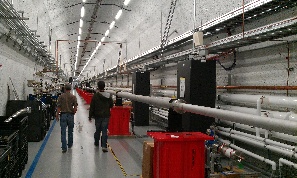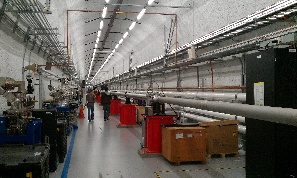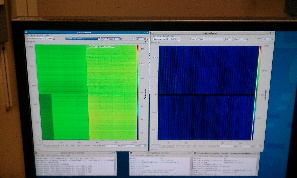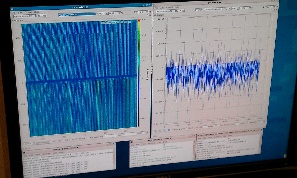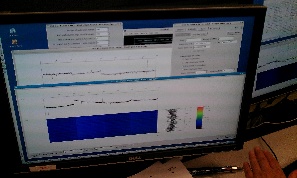Content
pnCCD overview
Large area pnCCD DAQ and Elictronics, Lothar Struder & Robert Hartmann
Development of calibration of pnCCD
2014-01-22 Meeting minutes
Hi everyone,
Here is a short summary of what I heard today for how we should start
with the pnCCD.
For pnCCD algorithms:
common-mode, pedestals, hot-pixels, quadrant rotations, hit-finders,
support in mikhail's calibManager
For pnCCD online displays: (using matplotlib for now)
shot by shot raw data
shot by shot calibrated data
projections of the above
region-of-interest
strip-charts of interesting quantities
(also display calibration values like noise-map,pedestal-map)
After this we will work on the acqiris as well (acqiris
constant-fraction algos already exist in psana).
Attached below is a 12 line python program that plots a real pnCCD
image and an x-projection (amoc0113 also has pnccd data we can look
at). You can run it on a psana node by saving it to pnccd.py and
doing "sit_setup" and then "ipython pnccd.py". This sort of code
should work online too (although we may have to change matplotlib
settings) as well as with calibrated images.
Display group (dan, mikhail, me) meets Thursday at 10:30. Analysis
group (sebastian, ankush(?), phil, mikhail, me) meets Friday at 1.
See you then...
chris
Script form Chris
Use interactive psana framework ~cpo/ipsana/shm.py:
from psana import *
events = DataSource('shmem=1_1_XCS.0').events()
src = Source('DetInfo(XcsBeamline.1:Tm6740.5)')
import matplotlib.pyplot as plt
plt.ion()
fig = plt.figure('pulnix')
ax = fig.add_axes([0.1, 0.1, 0.8, 0.8]) # x0, y0, h, w
for i in range(100):
evt = events.next()
frame = evt.get(Camera.FrameV1, src)
ax.cla()
ax.imshow(frame.data16())
fig.canvas.draw()
Walking and talking about unlimited pipeline (processing)
CASS Heritage
Online monitor
Data for tests
On 2014-01-27 Sebastian Carron kindly provide us with data files for pnCCD experiment amoa1214:
- Dark Run: 169, rear sensors gain 1/64, front 1/1, Imaging mode exp=amoa1214:run=169
- Run With Hits: 170 Low hit rate though, so you will have to use a hit finder of sorts exp=amoa1214:run=170
New modules for "old-style" calibration:
- pdscalibdata/include/PnccdBaseV1.h - baseclass for pnCCD parameters, defines Segs, Rows, Cols, Size
- pdscalibdata/include/PnccdPedestalsV1.h - loads pedestals from file, returns ndarray of pedestals
- pdscalibdata/include/PnccdCommonModeV1.h - the same for common mode
- pdscalibdata/include/PnccdPixelGainV1.h - the same for pixel gain
- pdscalibdata/include/PnccdPixelRmsV1.h - the same for pixel rms
- pdscalibdata/include/PnccdPixelStatusV1.h - the same for pixel status
- PSCalib::PnccdCalibPars - wrapper for all pnCCD types
Detector-dependent interface
Example can be found in PSCalib/test/ex_calib_file_finder.cpp:
// Assume that file is located in /reg/d/psdm/AMO/amotut13/calib/PNCCD::CalibV1/Camp.0:pnCCD.1/pedestals/1-end.data #include "PSCalib/PnccdCalibPars.h" const std::string calib_dir = "/reg/d/psdm/AMO/amotut13/calib"; const std::string group = "PNCCD::CalibV1"; // or std::string() const std::string source = "Camp.0:pnCCD.1"; unsigned long runnum = 10; unsigned print_bits = 255; PSCalib::PnccdCalibPars *calibpars = new PSCalib::PnccdCalibPars(calib_dir, group, source, runnum, print_bits); calibpars->printCalibPars(); ndarray<CalibPars::pedestals_t, 3> peds = calibpars -> pedestals_ndarr(); ndarray<CalibPars::common_mode_t, 1> cmod = calibpars -> common_mode_ndarr(); ndarray<CalibPars::pixel_status_t, 3> stat = calibpars -> pixel_status_ndarr(); ndarray<CalibPars::pixel_gain_t, 3> gain = calibpars -> pixel_gain_ndarr(); ndarray<CalibPars::pixel_rms_t, 3> gain = calibpars -> pixel_gain_ndarr(); // OR: CalibPars::pedestals_t* p_peds = calibpars -> pedestals(); CalibPars::common_mode_t* p_cmod = calibpars -> common_mode(); CalibPars::pixel_status_t* p_stat = calibpars -> pixel_status(); CalibPars::pixel_gain_t* p_gain = calibpars -> pixel_gain(); CalibPars::pixel_rms_t* p_rms = calibpars -> pixel_rms(); const size_t ndim = ndim(); const size_t size = size(); const unsigned* shape = shape(); etc...
Pros
- Simple format for calibration files - just a text file with pre-defined number of values for each type:
973.941639 881.189675 1050.211 773.263749 899.241302 981.805836 1150.72615 993.084175 1121.15488 1029.76319 1220.14927 903.278339 1097.49944 1066.94949 1263.71044 1053.53872 1194.35915 935.320988 1317 ...
Cons
- Too simple calibration file format, does not allow any metadata or comments.
- Detector-dependent objects and parameters "knows" about parameters' array type and shape:
- PSCalib::PnccdCalibPars which depends on PnccdPedestalsV1, PnccdCommonModeV1, ..., PnccdBaseV1
pdscalibdata::PnccdPedestalsV1::pars_t = float
pdscalibdata::PnccdCommonModeV1::pars_t = uint16_t
pdscalibdata::PnccdPixelStatusV1::pars_t = uint16_t
pdscalibdata::PnccdPixelGainV1::pars_t = float
- const std::string groupName = "PNCCD::CalibV1"; - do we really need it ?
Detector-independent interface
- Interface is declared in the abstract base class PSCalib::CalibPars
- Access to all detector-dependent classes is hidden in the static factory class PSCalib::CalibParsStore
Factory is implemented for pnCCD only. CSPAD and CSPAD2x2 will be added soon.
#include "PSCalib/CalibPars.h" #include "PSCalib/CalibParsStore.h" // Instatiation //Here we assume that code is working inside psana module where evt and env variables are defined through input parameters of call-back methods. //Code below instateates calibpars object using factory static method PSCalib::CalibParsStore::Create: std::string calib_dir = env.calibDir(); // or "/reg/d/psdm/<INS>/<experiment>/calib" std::string group = std::string(); // or something like "PNCCD::CalibV1"; const std::string source = "Camp.0:pnCCD.1"; const std::string key = ""; // key for raw data Pds::Src src; env.get(source, key, &src); PSCalib::CalibPars* calibpars = PSCalib::CalibParsStore::Create(calib_dir, group, src, PSCalib::getRunNumber(evt)); // Access methods calibpars->printCalibPars(); const PSCalib::CalibPars::pedestals_t* peds_data = calibpars->pedestals(); const PSCalib::CalibPars::pixel_gain_t* gain_data = calibpars->pixel_gain(); const PSCalib::CalibPars::pixel_rms_t* rms_data = calibpars->pixel_rms(); const PSCalib::CalibPars::pixel_status_t* stat_data = calibpars->pixel_status(); const PSCalib::CalibPars::common_mode_t* cmod_data = calibpars->common_mode();
Implementation of CalibParsStore
Module pdscalibdata::NDArrIOV1
New approach to calibration files with header
In order to get rid of detector dependent types of calibration parameters we need to add metadata in the calibration file. All metadata can be listed in the header of the calibration files, for example, using keyward mapping (dictionary):
pdscalibdata/test/test.data
# RULES:
# Lines starting with # in the beginning of the file are considered as comments or pseudo-comments for metadata
# Lines without # with space-separated values are used for input of parameters
# Empty lines are ignored
# REF: https://confluence.slac.stanford.edu/display/PCDS/pnCCD+processing+pipeline#pnCCDprocessingpipeline-CalibrationofpnCCD
# Optional fields:
# TITLE This is a file with pedestals
# DATE_TIME 2014-01-30 10:21:23
# AUTHOR someone
# EXPERIMENT amotut13
# DETECTOR Camp.0:pnCCD.1
# CALIB_TYPE center_um
# Mandatory fields to define the ndarray<TYPE,NDIM> and its shape as unsigned shape[NDIM] = {DIM:1,DIM:2,DIM:3}
# TYPE float
# NDIM 3
# DIM:0 3
# DIM:1 4
# DIM:2 8
21757 21769 33464 10769 68489 68561 77637 54810
21758 21773 33430 10628 68349 68345 77454 54729
21678 21820 33054 10637 68310 68254 77976 54617
21730 21755 33193 10904 68570 68456 77425 54648
33110 10457 68275 68299 56732 79628 21754 21558
33329 10446 68158 68183 56949 79783 21811 21779
33141 10369 68476 68506 57121 79700 21858 21839
33098 10477 68452 68416 56923 79666 21681 21761
51 18 -28 18 71 -20 -15 -54
178 61 257 247 161 231 111 106
1 -40 104 -24 9 -82 23 6
102 40 272 270 194 246 60 118
This C++ module is intended to read/write calibration files with header.
Interface description can be found in Doxygen doc for NDArrIOV1
pnCCD analysis for users
All other staff looks useful for all users and is migrated to the PSDM page: pnCCD processing pipeline
References
- psana - Module Examples
- Psana Module Catalog - Old
- Calibration Management Tool
- Mask Editor
- pnCCD processing pipeline - part of this page, which is useful for users
- CSPAD Calibration
- Large area pnCCD DAQ and Elictronics, Lothar Struder & Robert Hartmann
- doxy-doc for psana modules
- Doxygen doc for NDArrIOV1
- Doxy doc for CalibParsStore
